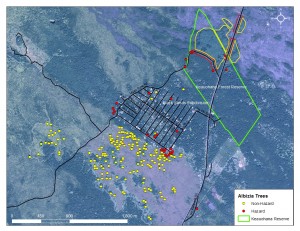State Lawmaker Also Targets ‘Tree That Ate Puna’
A project spearheaded by a Big Island lawmaker will take on the formidable albizia tree.
An appropriation of $35,000 will be used in a pilot control program aimed at removing specimens of the tree that are threatening homes, infrastructure and high-value forests.
The program is an offshoot of Senate Resolution 41, which was introduced by Puna Sen. Russell Ruderman and approved during the recent legislative session.
The measure directs the Hawaii Invasive Species Council to develop a statewide management plan for albizia, starting with the Big Island.
“As the fastest growing tree in the world, with brittle wood and shallow roots, albizia poses a serious threat to the public safety, infrastructure, economic viability and native forests across the state of Hawai’i,” Ruderman said in a statement.
The program to be administered by the Big Island Invasive Species Committee will focus on specific trees in the Keau`ohana State Forest Reserve and adjacent Black Sands subdivision located in lower Puna.

This map shows trees targeted in the demonstration area (click to enlarge). Image courtesy of BIISC.
“We identified this area of Puna as an ideal region to showcase the wide range of issues in albizia control, develop best management practices and empower communities to limit the spread of these menacing trees in their own neighborhoods,” said BIISC Manager Springer Kaye.
Ruderman’s statement noted that recent events provided a classic example of a problem associated with albizia. It said winds associated with Monday’s passing of Tropical Storm Flossie toppled an albizia trees onto power lines along Highway 132, closing the roadway and cutting power to more than 1,300 residents.
The plant colloquially known as the “tree that ate Puna” has had growth documented at up to an inch a day, and can easily reach heights of 100 feet or more.
Albizia trees are also nitrogen-fixers, which mean they create their own fertilizer in the soil. That can encourage the growth of other invasive species in forests, eventually crowding out native trees like the ohia which have evolved to grow in nutrient-poor soils.
There is also an effort underway to control albizia at the County Council level.
The money for the project is in addition to previously reported funding to the BIISC to battle invasive species.













